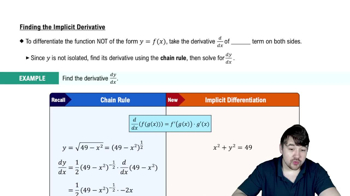Table of contents
- 0. Functions7h 52m
- Introduction to Functions16m
- Piecewise Functions10m
- Properties of Functions9m
- Common Functions1h 8m
- Transformations5m
- Combining Functions27m
- Exponent rules32m
- Exponential Functions28m
- Logarithmic Functions24m
- Properties of Logarithms34m
- Exponential & Logarithmic Equations35m
- Introduction to Trigonometric Functions38m
- Graphs of Trigonometric Functions44m
- Trigonometric Identities47m
- Inverse Trigonometric Functions48m
- 1. Limits and Continuity2h 2m
- 2. Intro to Derivatives1h 33m
- 3. Techniques of Differentiation3h 18m
- 4. Applications of Derivatives2h 38m
- 5. Graphical Applications of Derivatives6h 2m
- 6. Derivatives of Inverse, Exponential, & Logarithmic Functions2h 37m
- 7. Antiderivatives & Indefinite Integrals1h 26m
- 8. Definite Integrals3h 25m
4. Applications of Derivatives
Implicit Differentiation
Problem 3.8.46a
Textbook Question
45–50. Tangent lines Carry out the following steps. <IMAGE>
a. Verify that the given point lies on the curve.
x³+y³=2xy; (1, 1)
 Verified step by step guidance
Verified step by step guidance1
Substitute the coordinates of the point (1, 1) into the equation of the curve x³ + y³ = 2xy to check if it satisfies the equation.
Calculate the left-hand side of the equation by evaluating 1³ + 1³.
Calculate the right-hand side of the equation by evaluating 2 * 1 * 1.
Compare the results of the left-hand side and the right-hand side to determine if they are equal.
If they are equal, conclude that the point (1, 1) lies on the curve; if not, it does not.
Recommended similar problem, with video answer:
 Verified Solution
Verified SolutionThis video solution was recommended by our tutors as helpful for the problem above
Video duration:
1mPlay a video:
Was this helpful?

 5:14m
5:14mWatch next
Master Finding The Implicit Derivative with a bite sized video explanation from Nick
Start learningRelated Videos
Related Practice



